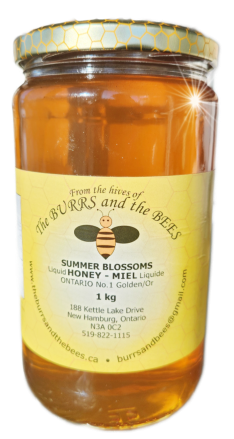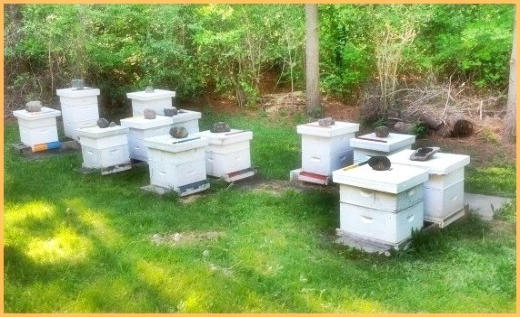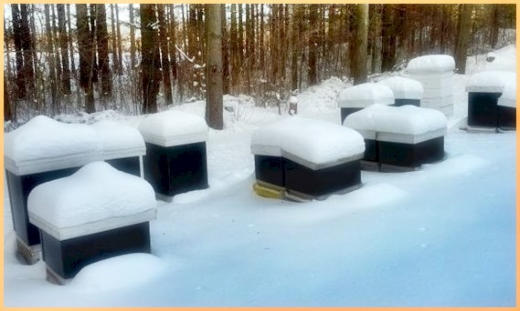From the Hives of the Burrs and the Bees Comes
Honey Fact
I Never give honey to children under one year of age. Honey sometimes contains dormant endospores of the bacterium Clostridium botulinum, which can be dangerous to infants as the endospores can transform into toxin-producing bacteria in the infant's immature intestinal tract, leading to illness and even death. For a fuller explanation please click here Tips for Storing Honey Store honey at room temperature – your kitchen counter or pantry shelf is ideal. Storing honey in the refrigerator accelerates the honey’s crystallization. Crystallization is the natural process in which in liquid honey becomes solid. If your honey crystallizes, simply place the honey jar in warm water and stir until the crystals dissolve. Or, place the honey in a microwave-safe container with the lid off and microwave it, stirring every 30 seconds, until the crystals dissolve. Be careful not to boil or scorch the honey. Health Benefits Research has shown that unlike most other sweeteners, honey contains small amounts of a wide array of vitamins, minerals, amino acids and antioxidants. Honey, a rich source of carbohydrates, provides a quick source of energy. Honey’s unique composition makes it an effective antimicrobial agent, useful for treating minor burns and scrapes, and for aiding the treatment of sore throats and other bacterial infections. (Read more in the Notes section under Cinnamon and Honey)

Cooking with Honey
For best results, use recipes developed for using honey. When
substituting honey for granulated sugar in recipes, begin by
substituting honey for up to half of the sugar called for in the
recipe. With a little experimentation, honey can replace all the
sugar in some recipes.
When baking with honey, remember the following:
• Reduce liquid called for by 1/4 cup for each cup of honey
used.
• Add 1/2 teaspoon baking soda for each cup of honey used.
• Reduce oven temperature by 25°F to prevent over-browning.
Because of its high fructose content, honey has a higher
sweetening power than sugar. This means you can use less
honey than sugar to achieve the desired sweetness.
When measuring honey, coat the measuring cup with non-stick
cooking spray or vegetable oil before adding the honey. The
honey will slide right out.
Why Do Bees Make Honey?
We know that bees have been producing honey as they do today
for at least 150 million years. Bees produce honey as food stores
for the hive during the long months of winter when flowers aren't
blooming and therefore little or no nectar is available to them.
European honey bees, genus Apis Mellifera, produce such an
abundance of honey, far more than the hive can eat, that humans
can harvest the excess. For this reason, European honey bees
can be found in beekeeper's hives around the world!
The Colony
Honey bees are social insects, with a marked division of labor
between the various types of bees in the colony. A colony of
honey bees includes a queen, drones and workers.

The Queen
The queen is the only sexually developed female in the hive. She is the largest bee in the colony.
A two-day-old egg is selected by the workers to be reared as the queen. She will emerge from her cell 16 days later to mate in flight with approximately 18 drone (male)
bees. During this mating, she receives several million sperm cells, which last her entire life span of two to four years. The queen starts to lay eggs about 10 days after
mating. A productive queen can lay 2,000 eggs in a single day.
The Drones
Drones are stout male bees that have no stingers. Drones do not collect food or pollen from flowers. Their sole purpose is to mate with the queen. If the colony is short on
food, drones are often kicked out of the hive.
The Workers
Workers, the smallest bees in the colony, are sexually undeveloped females. A colony can have 50,000 to 60,000 workers. The life span of a worker bee varies according
to the time of year. Her life expectancy is approximately 28 to 35 days. Workers that are reared in September and October, however, can live through the winter. Workers
feed the queen and larvae, guard the hive entrance and help to keep the hive cool by fanning their wings. Worker bees also collect nectar to make honey. In addition,
honey bees produce wax comb. The comb is composed of hexagonal cells which have walls that are only 2/1000 inch thick, but support 25 times their own weight. Honey
bees' wings stroke 11,400 times per minute, thus making their distinctive buzz.
FROM THE HIVES OF
The Burrs and the Bees
FROM THE HIVES OF
The Burrs and the Bees



















